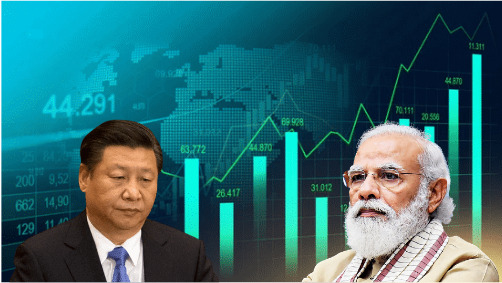The Indian economy is witnessing an unprecedented recovery, and the stock exchange is booming. Many do not consider stock exchange performances a reliable indicator of how well the economy is progressing to strengths, but there is a general unanimity that a booming stock market simply cannot be indicative of a disintegrating economy. Investors are bullish in India. Foreign investors are bullish about the Indian markets. So, something is going positive with the country’s economy in general. The Indian equity markets have now emerged as the best-performing among global peers on a year-on-year (YoY) and year-to-date (YTD) basis on the back of robust retail and institutional participation and better-earning prospects.
- As per a report by the Economic Times, India’s benchmark index Nifty is up 45% in the past 12 months and 19% on a year-to-day basis.
- Indian benchmarks have outperformed developed markets gauge MSCI World Index by 15% and 29% in the past 12 months and YTD (year-to-date) respectively.
- The return correlation between India and global equities has declined to 61% from over 80% a few months ago. This means that the Indian markets are increasingly growing independent of their foreign peers. Now, crests or troughs in foreign markets will have a lesser impact on Indian stocks. This, when seen through the context of Prime Minister Narendra Modi’s push for an ‘Aatmanirbhar Bharat,’ is a huge achievement.
- Finally, the market capitalisation of the Indian market has increased by a whopping $1 trillion in the past year, despite Covid-19 and its devastating economic impact the world over. Now, India’s market capitalisation stands at $3.2 trillion. This means Indian stocks are also the most expensive in the world with a valuation of 23 times FY22 expected earnings.
Booming Indian Markets
On Thursday (Sept 2), the domestic equity market witnessed yet another surge and moved past the key resistance level at 17,200 before ending above that. As per the Economic Times, the 17,200 marks had accumulated maximum Call open interest throughout the week. Investors, both domestic and international are upbeat about the strength of Indian markets and their ability to yield profits. A major reason for investors remaining bullish is the lack of extreme volatility in Indian markets, unlike the Chinese stock exchanges which are affected by Xi Jinping’s regulatory whims. In India, the Modi government has helped create a conducive, responsible environment for trading. This is leading to better earnings for Indian households and more foreign investment pouring in.
Indian stock markets are increasingly reflect increasing maturity in trading behaviours. Furthermore, India is earning a name for itself as a business-friendly destination around the world, where government interference in the industry is not something that people have to fear. Given how some markets in Asia themselves are behaving, India’s performance is nothing short of an overachievement, of which everyone should be proud. People are trusting India with their investments, and contributing to the country’s markets becoming among the most affluent in the world.
Doomed Chinese Markets
The market in Asia which we spoke about earlier is none other than that of China. Mind you, China’s markets are huge. They were considered a benchmark in Asia, but that was during the years when China was booming. Currently, China seems to have directed all its energies towards scaring off investors and regulating the markets, leading to trillions of dollars being wiped out in the blink of an eye. Under Xi Jinping, the Chinese markets have grown very volatile, and investors are turning to India instead – due to the steady and respectable position which our markets have come to command in the world.
For example, China is cracking down hard on its IT and Tech sectors. The value of China’s ten major tech companies had dissipated by over $800 billion until May this year itself. So, China is not the country any tech company would want to invest in. Outflows from the Chinese tech stocks due to the regulations in China seem to be resulting in inflows for the Indian tech companies, contributing to the Indian IT and tech sector becoming one of the biggest gainers following the coronavirus outbreak.
In July, following China’s crackdown on the Ed Tech sector, investors lost nearly $1 trillion as Chinese stocks tumbled in fear of the CCP’s blatant regulation and interference in the nation’s business environment, which by the way, is already very polluted.
India outpacing China
Moving forward, what would be best for India is the Chinese crackdown on businesses to continue. The CCP is shooting itself in the foot by interfering in the country’s markets. For India, domestic Chinese regulations are a blessing in disguise, as all of them are leading to the strengthening of Indian markets at a time when India’s markets are, in turn, growing independent of their foreign peers.
India’s gross domestic product (GDP) grew at a record pace of 20.1 per cent in the first quarter of FY22 — the highest-ever GDP growth in a single quarter. Thereafter, the GST collection numbers released on Wednesday for August showed a 30 per cent increase from the same month the previous year and, crossed the $1 trillion mark for the second consecutive month. The latest GDP figures and revival of the business activity in India above the pre-pandemic level is a vindication of the efforts and strategy of the Modi government and hopefully, it will put the country on a multi-year double-digit growth trajectory for a prolonged period. The stock markets are upbeat about the same, and that is a good sign for India.
